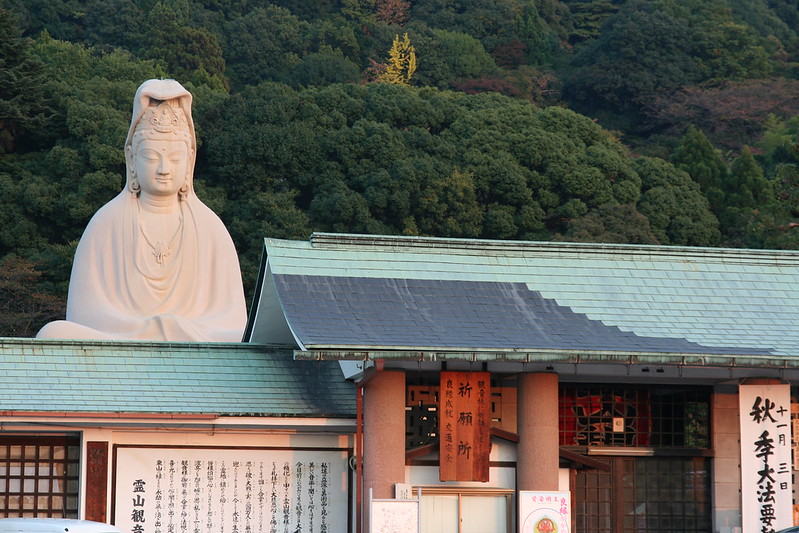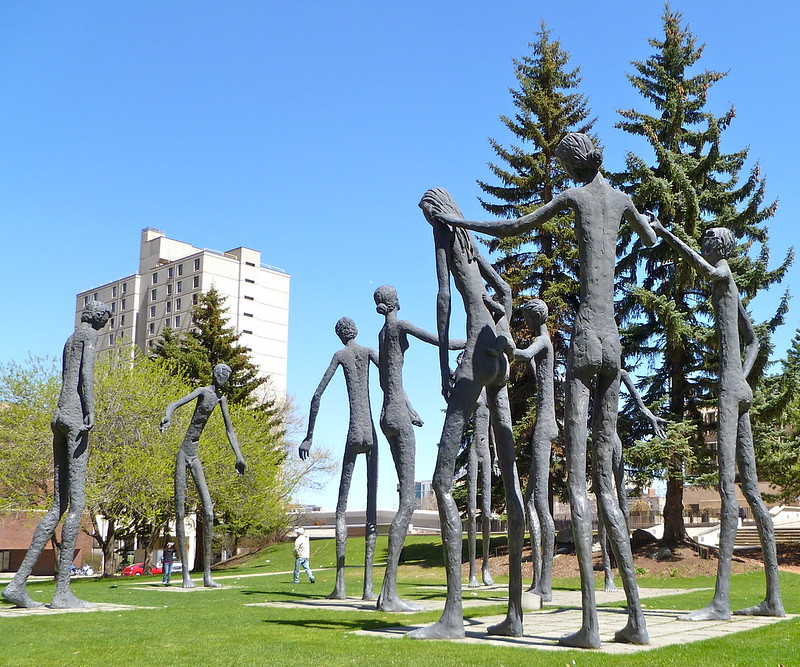How interacting with public art ignites moments of personal growth
There it was, on the other side of my known world, illuminating without light on a distant hill and being the view of a Westernized Japanese restaurant.
“That thing is huge,” was the only thing that crossed my mind after the glimpse of it had been so impactful that it stole my attention from the real-life geishas entering the precinct. The structures around it barely blocked the view of the base, and despite the distance, the details of her face were so clear that I could see her benevolent smile.

In a city, and to be honest, an entire country where spaces are tight and small, a 24 mts sculpture has a statute-of-liberty-like effect. Definetly off the beaten paths of Kyoto and overshadowed by traditional temples and attractions, this serene statue made me sit down, stop, look around, and find her.
“Who are you?” I asked her in my mind while grabbed by the heights and absorbed away from the restaurant atmosphere. This immaculate white sculpture replied by giving me more details of her face, inviting me to close my eyes with her. Immediately, I tapped into peace, into the now moment that I had forgotten because of the rushiness I had given to this trip. I opened my eyes and leaned my head in recognition of her teachings. I took a deep breath and allowed myself to take in the wonders of where I was––I was IN Japan, and this was a dream just a couple of years ago.
“Ryozen Kannon,” the waiter said, standing beside me and pointing at her. “Bodhisattva, Goddess of mercy.” He continued while vowing to her from afar.
“Arigatou,” I said, smiling and joining him in the vow.
You see, public art has a power we underestimate. The impact of a piece of art in a public space goes beyond mere city decoration. They stand there, emanating a message 24/7. Rain or shine, these structures persevere and give themselves to the passerby, always open to provide an opportunity to release insight.
Researchers have shown how public art “combats feelings of anxiety and isolation”(1) and how “people seem to use art in public spaces on their own terms”(2). It’s clear that the way we encounter art is not through casual observation only, as what could be easily understood as passive reception can evolve into reactive interaction when the artistic expression aligns with our life experience, and together, they enhance the moment we are in.
The first lines of this article narrate a personal experience, but there is no need to travel to faraway lands to fulfill a dream to experience this. Again, this is the power of public art, and if you are lucky enough, there is probably one closer than you think. Maybe around the corner, next to your office, or on the way to your favourite dinner spot.
That’s the case at the corner of 1st Street and 6th Avenue in Calgary, Alberta. What would be a simple crossing of the street to reach a government office to gather yet another set of paperwork became a journey of bond, care, and family.

I was suddenly surrounded by 24-foot-high figures interacting next to and above me. An interaction that I don’t know how; I was part of it too. All of us were actively part of the whole. No clear faces or races, only human shapes, engulfed me and made me, for a few minutes, part of them. After a couple more steps, I was out of all the action that included representations of couples, friends, children, and individuals. In short, it took me a short walk to redefine the concept of connection and witness how big brotherhood/sisterhood can be.
However, alongside these kinds of experiences, the questioning regarding the value and importance of art prevails. The narrative that states that art education in high Schools is unnecessary continues to trigger cuts in the budget and participation of the arts in the government’s agenda. But we can’t say their premise is nonsense, as they also have strong points and research to support their view.
When revising a good number of studies (3) about arts education, many were either done with too small samples or didn’t follow randomization practices to avoid experiment manipulation. That makes many of the conclusions used to credit Art for expanding individual competencies and providing a more holistic human experience just correlational and not that scientific. To be fair and in plain language, the widely use argument of GPAs being usually higher in students who took art classes doesn’t have actual proof that art classes are the cause.
Either way, the current reality is that art expression and education are struggling, and at this pace, it feels public art is the best free art class the urbs will be able to offer to adults and kids alike.
Art, in general, is a passage to a self-reflective state. Public art provides that on steroids, as it usually delivers an immersion in the art itself. Its magnificent and hugging qualities translate into opportunities to enter that zone of focused attention, pleasure, and realization faster and more profoundly.
Public art is quite literally an open-air lecture room that teaches you to look around and allow yourself to reflect, see beyond the literality of life and have moments of insight.
Here is for the diverse art encounters we all can have in the urban areas we call home, the chances to be part of our city’s art masterclasses, and the invitation to you to look up and down. Who knows, you might have a once-in-a-lifetime insight by just walking around.
References
- Happy City Denver: Art for the People Experiments Report Executive Summary. https://admin.happycities.com/wp-content/uploads/2020/11/Happy-Denver_Final-Report.pdf
- The Uses of Art in Public Space. Chapter: Framing art and its uses in public space. https://www.taylorfrancis.com/chapters/edit/10.4324/9781315757018-1/framing-art-uses-public-space-quentin-stevens-julia-lossau
- Arts in Education: A Systematic Review of Competency Outcomes in Quasi-Experimental and Experimental Studies. https://www.frontiersin.org/articles/10.3389/fpsyg.2021.623935/full